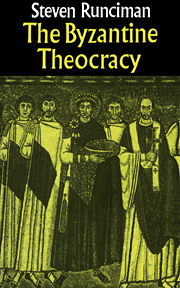Book contents
- Frontmatter
- Contents
- Foreword
- Introduction
- 1 The Christian Empire: The image of God upon earth
- 2 The Viceroy of God: The plenitude of Imperial power
- 3 The battle over images: The challenge of popular belief
- 4 The working compromise: The limits of Imperial control
- 5 The monks and the people: The opposition to the palace and the hierarchy
- 6 Decline and fall: The end of the Kingdom of God on earth
- Notes
- Index
6 - Decline and fall: The end of the Kingdom of God on earth
- Frontmatter
- Contents
- Foreword
- Introduction
- 1 The Christian Empire: The image of God upon earth
- 2 The Viceroy of God: The plenitude of Imperial power
- 3 The battle over images: The challenge of popular belief
- 4 The working compromise: The limits of Imperial control
- 5 The monks and the people: The opposition to the palace and the hierarchy
- 6 Decline and fall: The end of the Kingdom of God on earth
- Notes
- Index
Summary
The twelfth century was the last period in which Byzantium was still an Imperial power; and even then its splendour was more apparent than real. Constantinople was still the richest city in Christendom, with its factories and workshops and its busy markets. But the money that was made there was passing more and more into the purses of Italian merchants. The Imperial army was still a formidable fighting force; but it was composed mainly of foreign mercenaries, costly to maintain and uncertain in their loyalty. The social problems of the mid eleventh century and the political problems that followed upon the end of the Macedonian dynasty had combined with the irresponsible folly of the Emperors and their advisers to allow Turkish invaders to sweep over Anatolia and establish themselves in districts that in the past had supplied most of the soldiers for the army and most of the food for the capital. At the same time upstart Normans attacked the Empire from the West. The recovery under the first Comnenian Emperors had been remarkable; but it was insecurely based. It had been achieved largely through clever diplomacy, in particular by gaining the help of the Venetians, who demanded commercial privileges as their reward; and the other great Italian merchant-cities forcibly demanded similar advantages. The Crusading movement had been at first of use to the Empire; but almost from its outset it caused more ill will than goodwill between Eastern and Western Christendom; and the ill will increased as the schism between the Churches deepened.
The Byzantines themselves sensed that they were living in a changing and uncertain world. Their feeling is visible in the art of the twelfth century.
- Type
- Chapter
- Information
- The Byzantine TheocracyThe Weil Lectures, Cincinatti, pp. 135 - 164Publisher: Cambridge University PressPrint publication year: 1977



